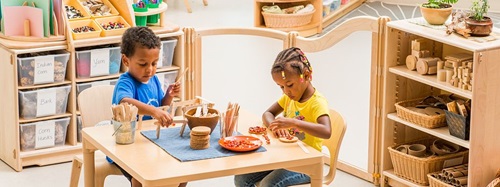Reconsidering Everyday Early Childhood Practices
The Settled Classroom Using the Complementary Curriculum Approach
| December 2023“The children are being destructive with materials. They are basically dumping out the container and moving to the next activity without focus.”
“The children don’t stay with an activity or really get invested in it unless I am with them the whole time, and I can’t always do that!”
“I thought the things I put on the tables would be fun for them to play with, but all they did was argue over the toys and then move onto something else.”
“I want to do more inquiry-based learning, but I just don’t have the time to fit it in.”
At the end of a busy day in the classroom, have you found yourself saying something similar to any of these statements?
Teachers experience joy and success in their work every day, but many are also at a loss for how to solve some of the daily challenges. When looking at challenges in a classroom it is easy to reason that children’s behavior is the problem. But all behavior is a form of communication. What are the children telling us? What are they communicating through their actions?
When we stop to look at it, children’s communication is clear: they want more engaging materials, with abundant time to play and explore. Children want to make choices for themselves and have some agency over their own learning.
Children are not the problem. As a field, we have polarized ourselves. On one hand, we want to promote play-based experiences and open-ended, creative opportunities with loose parts and multiple entry points. Developmentally Appropriate Practice tells us children learn through play and hands-on offerings. On the other hand, teachers are under increasing pressure to build skills to bridge the achievement gap. Teachers feel caught in this divide often creating unsettled environments where learning opportunities are lost due to behavioral issues.
How can our classrooms become settled environments where children engage in relevant learning experiences and joyful play? How can educators support children’s play and cultivate classroom environments with rich, interesting learning experiences at the core?
Teachers need to prepare themselves, the environment, and the materials; planning what they will do and say when they are teaching – before the children enter the classroom. A teacher’s job is to promote play-based experiences and open-ended creative opportunities, interwoven with academic skill-based experiences. Children naturally play and learn in ways that meet their inquisitive nature, curiosity, and developmental needs, supporting their intellectual, social, emotional, and physical development while learning to love learning.
We have discovered four areas which we call the Four Intentions to support a settled environment. They are: Compelling Materials, Explicit Presentation, Responsive Scaffolding, and Following Children’s Interests.
The Four Intentions
The Four Intentions are the core of Complementary Curriculum and following them, guides strong, high quality classroom experiences. We define “intention” as a purposeful aim, plan, or provocation that guides productive action in the classroom. The intentions are directly related to practices that teachers carry out daily as they work with children and develop purposeful curriculums. The Four Intentions complement each other and when used together allow a beautiful and rich curriculum to emerge.
Compelling Materials
In too many classrooms, teachers tell children where to play, how long to play there, and when to move to another play area. To spark interest and inspire children’s inquiry, it is important to intentionally choose materials. Classroom shelves and interest areas should be set up with materials in a way that allows children to make their own choices. Compelling materials evoke interest, sustain attention, inspire curiosity, and invite children into increasingly more complex interactions with materials and each other.
Design and provision your classroom with materials that are relevant to children’s changing interests and the curriculum goals in your school, program, or center. Sort through your stored materials regularly, discarding broken or damaged items and reclaiming the ones your children will find intriguing. In this way you can use all the things you have in your cabinets, add new elements, and build children’s capacity for engagement.
Consider child-accessible storage options: trays, baskets, or dishes to invite children’s curiosity in each classroom center. Knowing your children and their unique characters and interests will guide the way you present the materials for discovery.
Explicit Presentation
Unless children are explicitly taught how to get the materials they have been using ready for the next person, they will leave trails of materials all around the classroom, and teachers will shift into the “busy server” mode, cleaning up after everyone. Without explicit presentations about how to use materials, care for them, and ready them for other children, classrooms become overrun with abandoned materials and activities.
Explicit Presentation refers to the practice of modeling everyday routines, activities, and the use of classroom materials, through descriptive language and non-verbal cues. Help children to use materials purposefully without sacrificing discovery, exploration, and play. Self-care routines, care of the community, and specific lessons about materials help children engage independently with compelling materials.
Responsive Scaffolding
Being an early educator is grounded in the joy of observing children as they discover new possibilities and supporting them in leaps of understanding and awareness.
Responsive Scaffolding refers to the supportive teacher interactions that build and expand children’s experiences. How teachers observe and listen to children, the language they use, and how they move in and out of children’s experiences, encouraging children’s learning.
Children thrive when they have the time and support to hunker down with a task, game, or creative project and follow it through to a satisfying completion. When children experience repeated success, their self-esteem grows. Children, indeed, all of us, want to feel successful and capable. Interesting, fun, joyful play creates the conditions that promote children’s sense of themselves as people who can successfully take on projects that matter to them. When they navigate the challenges, aha moments, and discoveries that come with any meaningful pursuit, children develop trust in their competence and a feeling that “I can do it!”
As you really get to know the children in your classroom, their interests, personalities, and learning styles, you will learn how to best support every child.
Following Children’s Interests
Following familiar curriculum themes, using the same activities year after year makes planning easy, but can also become routine and uninteresting for teachers and for children. Often, pre-planned offerings are detached from children’s lives, communities, and interests. Following Children’s Interests prepares us to teach in ways that support child-led learning driven by big ideas. Following Children’s Interests also means offering them the opportunity to choose materials that they want to do, providing agency in learning. By following children’s interests, teachers are less likely to succumb to a pitfall of thematic curriculum—short-term, adult-centered, irrelevant activities. A teacher’s ability to know what children think, feel, and wonder is at the core of a settled, responsive, and engaged classroom.
Conclusion
There is pressure in our classrooms to continue working in the ways we always have but we have to confront some of the practices that are not serving us well. This is about children, but it is also about you and your practice. We can give explicit presentations while still providing open ended opportunities. You can offer freedom for play and inquiry without sacrificing structured, scaffolded experiences. Using the Four Intentions can lead to a settled environment in your classroom where children can thrive and learn through play.
Let's invigorate our teaching and classrooms to be a joyful setting for all.
Article based on excerpts from: Kuh, Lisa, PhD; Ponte, Iris, PhD. 2023. The Complementary Curriculum Approach. Transform Your Practice Through Intentional Teaching. Nebraska: Exchange Press.
For more on settled environments and the Complementary Curriculum Approach, Browse the Book, or Take Lisa and Iris's online course.
Copyright ©Exchange Press. Follow Lisa and Iris’ work at: https://complementarycurriculum.com














